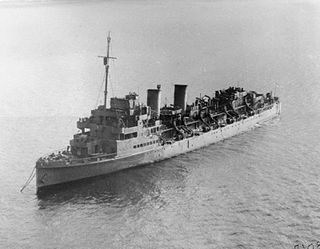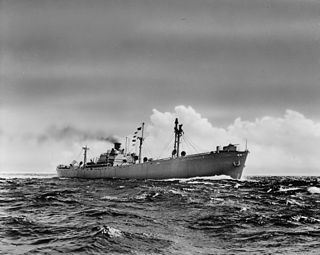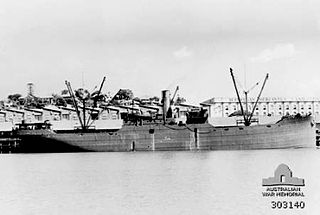
SM U-151 or SM Unterseeboot 151 was a World War I U-boat of the Imperial German Navy, constructed by Reiherstieg Schiffswerfte & Maschinenfabrik at Hamburg and launched on 4 April 1917. From 1917 until the Armistice in November 1918 she was part of the U-Kreuzer Flotilla, and was responsible for 34 ships sunk (88,395 GRT) and 7 ships damaged.

USS Starlight (AP-175) was a United States Navy Storm King-class auxiliary transport in commission from 1944 to 1945. She was designed as a troop carrier. After her naval service she became the civilian cargo ship SS Badger State. She sank in January 1970 after an explosion of a cargo of munitions on December 26, 1969, with the loss of 26 of her crew of 40

Cory Environmental is a large resource management, recycling and energy recovery company in the United Kingdom. Cory operates in nearly 40 locations throughout England, providing services in the collection, recycling and disposal of waste.

Renown was a barque used as a sailing cargo ship built in 1842 by R. & H. Green in Blackwall, London. She survived a cyclone at Calcutta in 1864, and was sold to German owners in 1882. In 1887 or 1888 she foundered off Den Helder on the Dutch coast.
SS Bengrove was a steam-powered collier registered in Liverpool, England. Thousands of people on shore saw her explode and sink in the Bristol Channel on Sunday, 7 March 1915.

The SS Gairsoppa was a British steam merchant ship built in Jarrow and launched in 1919. After a long civilian career, she saw service during the Second World War. She was named in honour of the town of Gerusoppa on the banks of River Sharavati in Karnataka, India, which due to its easy access to water transportation and as a distribution centre for crops including pepper, was the commercial capital for centuries.
SS Gallois was one of seven merchant vessels which became stranded and then wrecked on Haisbro Sands of the Norfolk coast on 6 August 1941 during the Second World War. The SS Gallois had been part of a convoy with the designation Convoy FS 559.
SS Primrose Hill was a British CAM ship that saw action in World War II, armed with a catapult on her bow to launch a Hawker Sea Hurricane. She was completed by William Hamilton & Co in Port Glasgow on the Firth of Clyde in September 1941.

Henry Ramey Upcher was the second private lifeboat to be stationed in the English town of Sheringham in the county of Norfolk She was launched on 4 September 1894 and stayed on station for 41 years until she was slowly retired from duty and by 1935 had ceased rescue work completely. The Lifeboat is now on permanent display in her own museum housed in her converted original boat shed.

RNLB Emma Constance was a Barnett-class lifeboat stationed at Aberdeen Lifeboat Station, in the Scottish city of Aberdeen from 1927 until August 1951. The lifeboat was designed by James R. Barnett who was a consulting naval architect to the Royal National Lifeboat Institution (RNLI).
SS Stolwijk, a Dutch cargo ship of 2,489 tons, was wrecked off the coast of Donegal on 6 December 1940. She was part of a Convoy SC 13 sailing from the Dominion of Newfoundland to Liverpool, England, when her rudder was damaged in a fierce storm. Attempts to rescue her by her destroyer escort failed and she went on the rocks off Tory Island, County Donegal, Ireland. Ten of her crew were lost but the remaining 18 were rescued the following day by Arranmore Lifeboat and landed safely in Burtonport. The rescue of the survivors was conducted in terrible weather conditions and both the RNLI and Queen Wilhelmina of the Netherlands awarded medals to the Irish lifeboat crew.

SS Prinses Astrid was a Belgian cross-Channel ferry struck a naval mine 3 nautical miles (5.6 km) off the coast of Dunkirk, France and sank with the loss of five of her 65 crew. All 60 survivors and 218 passengers on board were rescued by SS Cap Hatid (France) and various tugs from Dunkirk.

SS Ardmore was an Irish Cargo ship that was torpedoed by SM U-95 in St. George's Channel 13 nautical miles (24 km) west south west of the Coningbeg Lightship on 13 November 1917 while carrying general cargo from London, United Kingdom to Cork, Ireland.

The SS Clarksdale Victory was the 80th Victory ship built during World War II. She was launched by the California Shipbuilding Company on January 27, 1945, and completed on February 26, 1945. The ship’s United States Maritime Commission designation was VC2-S-AP3, hull number 80. She was built in just 86 days under the Emergency Shipbuilding program. SS Clarksdale Victory served in the Pacific Ocean during WW2. SS Clarksdale Victory was 80th of the new 10,500-ton class ship known as Victory ships. Victory ships were designed to replace the earlier Liberty Ships. Liberty ships were designed to be used just for WW2. Victory ships were designed to last longer and serve the US Navy after the war. The Victory ship differed from a Liberty ship in that they were: faster, longer and wider, taller, a thinner stack set farther toward the superstructure and had a long raised forecastle.

SS Anne Hutchinson was a Liberty ship built by the Oregon Shipbuilding Company of Portland, Oregon, and launched on 31 May 1942 The ship was named after the Anne Hutchinson, a 1600 Massachusetts Bay Colony Puritan.

The SS Samoa was a 1,997-ton cargo ship that was able to escape an attack off the coast of California in the early days of World War II. The Samoa was built under a United States Shipping Board (USSB) contract in 1918 as the SS Muerthe, but was launched as the USS Lake Pepin, named after Lake Pepin, by the McDougall Duluth Shipbuilding Company of Duluth, Minnesota measured at 3,600 tons deadweight. She had a triple expansion engine steam engine with 1,250 horsepower (930 kW), a 251-foot (77 m) length, 43.5-foot (13.3 m) beam, a draft of 17 feet 8+1⁄2 inches (5.398 m), a top speed of 9.25 knots. The vessel had a crew of 52, with the hull # 9 and O.N.ID # 21699. The USS Lake Pepin was owned and operated by the United States Navy, commissioned at Montreal, Quebec, Canada on September 4, 1918. For World War I she was fitted with one 3"/50 caliber gun. The Navy put her in Naval Overseas Transportation Service as a coal carrier traveling between the United Kingdom and France as a United States Navy Temporary auxiliary ship. Her coal service ended in May 1919. In June 1919 she returned to the US with a cargo of World War I vehicles and weapons and unused ammunition. The US Navy decommissioned the Lake Pepin on June 18, 1919. In 1923 she was, renamed Samoa purchased and operated by the Hammond Lumber Company. In 1936 she was sold to the Wheeler Logging Company of Portland, Oregon. In February of 1941 she was sold to W. A. Schaefer Company.

SS Coast Trader was built as the cargo ship SS Holyoke Bridge in 1920 by the Submarine Boat Company in Newark, New Jersey. The Coast Trader was torpedoed and sank 35 miles (56 km) south west of Cape Flattery, off the Strait of Juan de Fuca in U.S. state of Washington by the Japanese submarine I-26. Survivors were rescued by schooner Virginia I and HMCS Edmundston. She rests on the ocean floor at.
SS Hartlebury was a cargo steamship that was launched in Scotland in 1934 for J&C Harrison Ltd. A U-boat sank her in the Barents Sea in 1942 when Hartlebury was a member of the Arctic convoy Convoy PQ 17.












